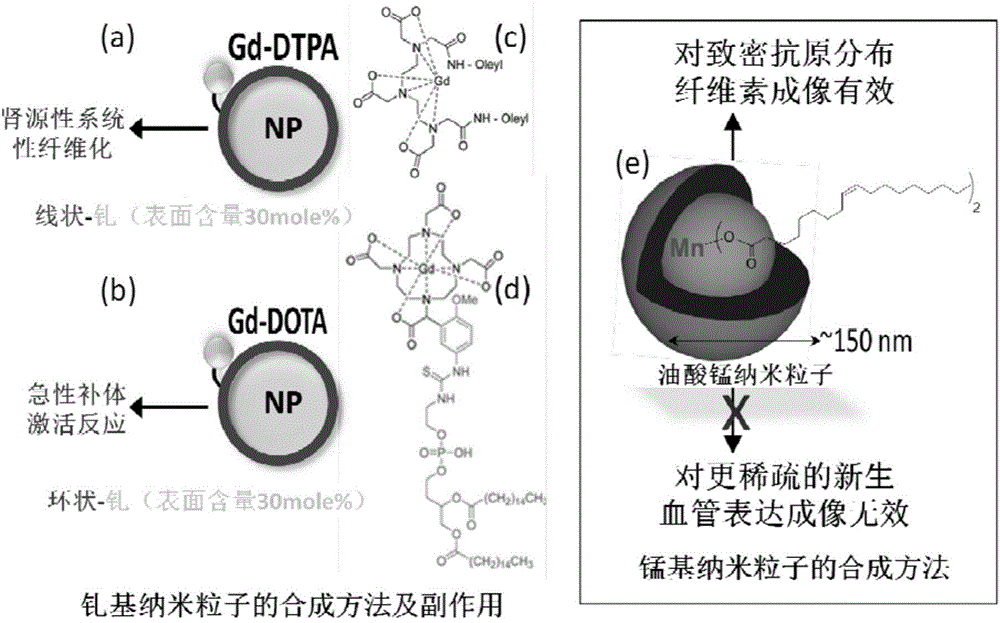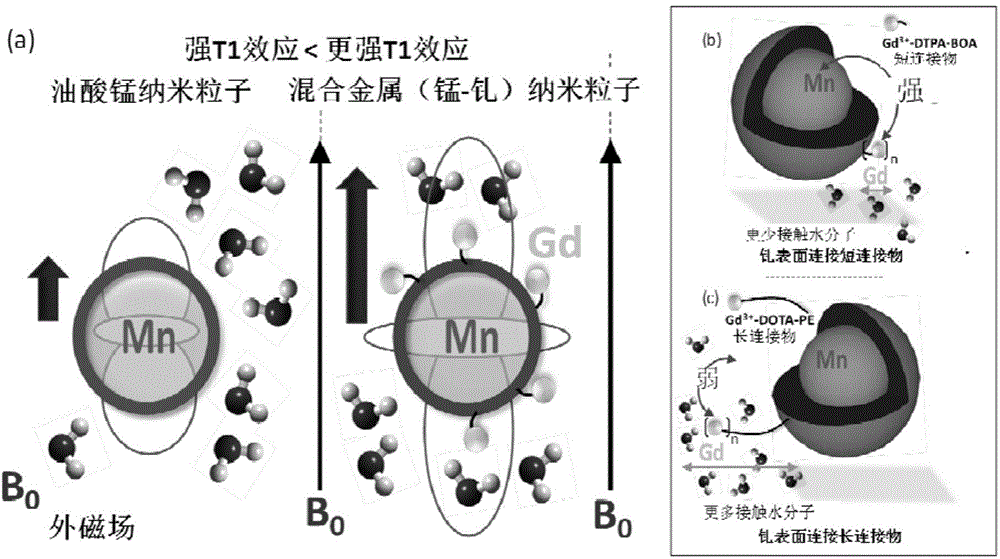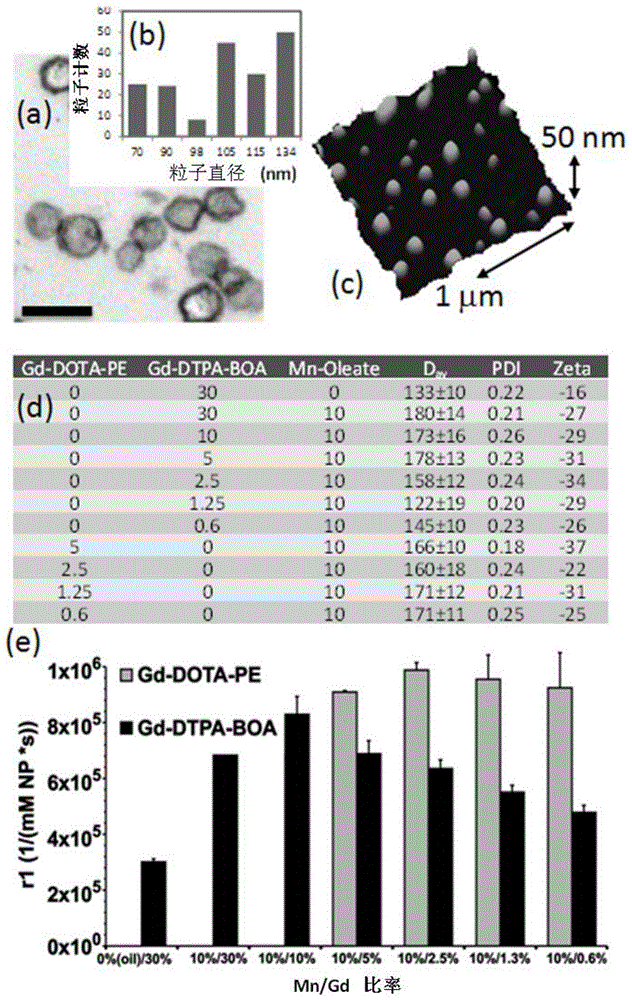Manganese gadolinium heterozygous bimetallic paramagnetic nanocolloid and application in preparation of magnetic resonance imaging contrast material thereof
A paramagnetic nano, bimetallic technology, applied in the field of medicine, can solve problems such as acute complement activation, and achieve the effects of reducing side effects, improving biological safety, and reducing load
- Summary
- Abstract
- Description
- Claims
- Application Information
AI Technical Summary
Problems solved by technology
Method used
Image
Examples
Embodiment 1
[0039] Example 1 Preparation of manganese-gadolinium hybrid bimetallic paramagnetic nanoparticle colloid (MnOL-(1.25mol%)Gd-DOTA-PE NC).
[0040] Manganese-gadolinium hybrid bimetallic paramagnetic nanoparticle colloids (MnOL-Gd NC) were synthesized by a two-step method.
[0041] 1. Add 360ml of ethanol-water-n-hexane mixture into a 500ml round bottom flask, add 10g of manganese chloride tetrahydrate (MnCl 2 .4H 2 O) and 40g sodium oleate (TCI chemical), reacted at 80°C for 14 hours, then reacted at 25°C for 4 hours, washed with water, salt, Na 2 SO 4 After drying and rotary evaporating to dryness to remove the solvent, divalent MnOL is prepared, wherein, in the mixture of ethanol-water-n-hexane, the volume ratio of ethanol, water and n-hexane is 4:5:9;
[0042] 2. Under a nitrogen atmosphere, suspend 10 g of divalent MnOL in 20 mL of sorbitan sesquioleate as an internal matrix, add a phospholipid surfactant at 141 MPa and 4 °C, Fully mixed, the final concentration of the ...
Embodiment 2
[0044] Example 2 Preparation of manganese-gadolinium hybrid bimetallic paramagnetic nanoparticle colloid (MnOL-(1.25mol%)Gd-DTPA-BOA NC)
[0045] Manganese-gadolinium hybrid bimetallic paramagnetic nanoparticle colloids (MnOL-Gd NC) were synthesized by a two-step method.
[0046] 1. Add 360ml of ethanol-water-n-hexane mixture into a 500ml round bottom flask, add 10g of manganese chloride tetrahydrate (MnCl 2 .4H 2 O) and 40g sodium oleate (TCI chemical), reacted at 80°C for 14 hours, then reacted at 25°C for 4 hours, and after the solvent was removed by rotary evaporation, divalent MnOL was prepared, wherein, in the mixture of ethanol-water-n-hexane, The volume ratio of ethanol, water and n-hexane is 4:5:9;
[0047] 2. In a nitrogen atmosphere, suspend 10g of divalent MnOL in 20mL of polysorbate 80 as the internal matrix, add phospholipid surfactant at 141 MPa and 4°C, and mix thoroughly, the added phospholipid surface The final concentration of the active agent is 0.02g / ml...
Embodiment 3
[0049]Example 3 Preparation of manganese-gadolinium hybrid bimetallic paramagnetic nanoparticle colloid (MnOL-(2.5mol%)Gd-DOTA-PE NC)
[0050] Manganese-gadolinium hybrid bimetallic paramagnetic nanoparticle colloidal MnOL-Gd NCs were synthesized by a two-step method.
[0051] 1. Add 360ml of ethanol-water-n-hexane mixture into a 500ml round bottom flask, add 10g of manganese chloride tetrahydrate (MnCl 2 .4H 2 O) and 40g sodium oleate (TCI chemical), reacted at 75°C for 16 hours, then reacted at 24°C for 5 hours, and after the solvent was removed by rotary evaporation, divalent MnOL was prepared, wherein, in the mixture of ethanol-water-n-hexane, The volume ratio of ethanol, water and n-hexane is 5:5:8;
[0052] 2. In a nitrogen atmosphere, suspend 10 g of divalent MnOL in 25 mL of polysorbate 80 as an internal matrix, add a phospholipid surfactant at 150 MPa and 20 ° C, and mix thoroughly. The added phospholipid surface The final concentration of the active agent is 0.025...
PUM
| Property | Measurement | Unit |
|---|---|---|
| Concentration | aaaaa | aaaaa |
Abstract
Description
Claims
Application Information
 Login to View More
Login to View More - R&D
- Intellectual Property
- Life Sciences
- Materials
- Tech Scout
- Unparalleled Data Quality
- Higher Quality Content
- 60% Fewer Hallucinations
Browse by: Latest US Patents, China's latest patents, Technical Efficacy Thesaurus, Application Domain, Technology Topic, Popular Technical Reports.
© 2025 PatSnap. All rights reserved.Legal|Privacy policy|Modern Slavery Act Transparency Statement|Sitemap|About US| Contact US: help@patsnap.com



